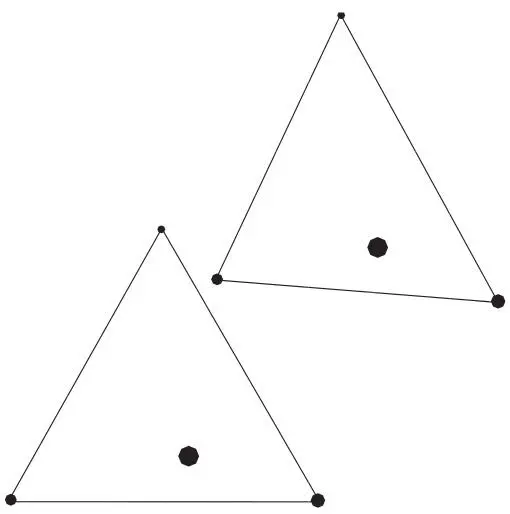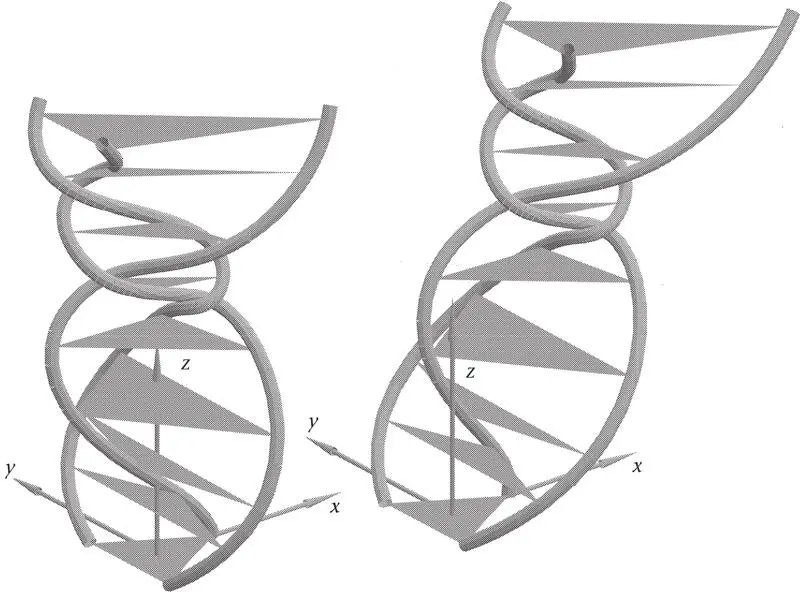Playing the role of Laplace’s divinity, we place the first triangle, at the instant when Newton’s grandstand clock says it is noon, at some position in absolute space. A second later, we place the second triangle somewhere near it in a slightly different position. The first triangle defines the initial positions of the three bodies. Given the position of the second triangle one second later, we can calculate the initial motions, since we know where the particles have gone and how long it took them. (Strictly, to calculate the instantaneous velocities we must take an infinitesimal time interval, not one second, but that is a minor detail). Imagine now that a strobe light illuminates the bodies with a flash once every second, corresponding to the seconds ticking on Newton’s clock, so that we can watch how the triangle formed by the bodies moves through absolute space. We have seen this already, in Figure 1. We can also plot the points corresponding to the triangles in either Triangle Land or Shape Space, obtaining a curve like those in Figures 9 and 10. This abstracts away the extra Newtonian information – the positions in absolute space and the time separations – that we possessed originally.
Now, wherever we place the two triangles, the resulting curves in either Triangle Land or Shape Space will all start at the same point, since we always begin with the same triangle, and that corresponds to just one fixed point in Platonia. The curve must also have the same initial direction, since that is determined by the position of the second triangle in Platonia, which is also fixed. This is explained in the caption to Figure 10. The question is, how does the curve run after that? What effect do the positioning of the first two triangles in absolute space and the time separation have on the subsequent evolution?
To answer this question, we need the notion of centre of mass (Box 4). For a given triangle, there are two different things to bear in mind when it comes to placing it in absolute space. First, we can place its centre of mass anywhere. Since space has three dimensions, this means that we can shift the centre of mass along three different directions. Physicists say that in such cases there are three degrees of freedom . Second, holding the centre of mass fixed, we can change the orientation of the triangle in space. This introduces three more degrees of freedom. To see this, picture an arrow passing through the centre of mass perpendicular to the triangle. It will point to somewhere on the two-dimensional sky, giving two degrees of freedom. The third arises because one can, keeping the arrow fixed, rotate the triangle around it as an axis.
BOX 4 Centre of Mass
The centre of mass of a system of bodies is the position of a fictitious mass equal to the sum of the masses of the system. For two unequal masses m and M , it lies on the line joining them at the position that divides the line in the ratio M/m – that is, closer to the heavier mass in that proportion. For any isolated system of bodies, the centre of mass either remains at rest or moves uniformly in a straight line through absolute space. The centre of mass for three bodies is shown in Figure 11.

Figure 11.Masses of 1, 2 and 3 units (indicated by their sizes) are shown at the vertices of the two slightly different triangles (which correspond to the two triangles discussed in the main text). The two centres of mass are shown by the big blob (mass 6 units). The position of the centre of mass is found by finding the centre of mass of any pair and then the centre of mass of it and the remaining third mass.
Now, wherever we place the centre of mass of the first triangle, and however we orient it, the sequence of triangles that then arises is always the same. The path traced out in Platonia is the same. The starting position in absolute space does not matter an iota. This is rather remarkable. It is as if you could grow identical carrots in your garden, at the bottom of the sea, and in outer space. Different locations in absolute space have a decidedly shadowy reality. Unlike real locations on the Earth, they do not have any observable effects.
The ‘location in time’ is equally difficult to pin down. We started our experiment at noon according to Newton’s clock. In fact, the starting time has no influence whatsoever: all the ‘carrots’ come out just the same. So, as far as the position of the first triangle in both absolute space and time is concerned, it has no influence whatsoever. We begin to wonder whether they play any role at all. This doubt is strengthened when we consider where to place the second triangle. It turns out that we can position its centre of mass anywhere in absolute space relative to the first triangle. This too has no effect at all on the sequence of triangles that then follow. This absence of effect is due to so-called Galilean relativity, which is one of the most fundamental principles of physics (Box 5).
BOX 5 The Galilean Relativity Principle
Galileo noted that all physical effects in the closed cabin of a ship sailing at uniform speed on a calm sea unfold in exactly the same way as in a ship at rest. Unless you look out of the porthole, you cannot tell whether the ship is moving. Quite generally, in Newtonian mechanics the uniform motion of an isolated system has no effect on the processes that take place within it. The left-hand diagram in Figure 12 shows (in perspective) the triangles formed by the three gravitating bodies in the history of Figure 10 at equal intervals of absolute time. The individual bodies move along the ‘spaghetti’ tubes. The centre of mass moves uniformly up the z axis. (Despite appearances, the triangles are always horizontal, i.e. parallel to the xy plane.) The right-hand diagram has two physically equivalent interpretations. First, it is how observers moving uniformly to the left past the system on the left would see that system receding behind them. Second, it is also how observers at rest relative to the system on the left would see a system identical to that system except for a uniform motion of the centre of mass to the right. This is how the happenings in the cabin of Galileo’s galley would be ‘sheared’ to the right for observers standing on the shore. Depending on the speed of the system, the centre of mass will be shifted in unit time by different amounts, but the actual sequence of triangles remains the same. This corresponds to the freedom mentioned in the text.
Because of the relativity principle, the laws of motion satisfied by bodies take exactly the same form in any frame of reference moving uniformly through absolute space as they do in absolute space itself. Although Newton did not like to admit it, this fact makes it impossible to say whether any such frame, which is called an inertial frame of reference , is at rest in absolute space or moves through it with some uniform velocity. Bodies with no forces acting on them move in a straight line with uniform speed in any inertial frame of reference (hence the name). It is impossible to say that you are at rest in absolute space, only that you are at rest in some inertial frame of reference. For historical reasons I use ‘absolute space’ in the text, but strictly I should be using ‘any inertial frame of reference’.

Figure 12.Unlike Figures 9 and 10 (and the later Figure 14), the lines followed by the spaghetti strands in this figure (and also Figure 13) show the tracks of the three individual particles in space. This is why there are three strands and not a single curve. It will help you a lot if you can get used to thinking about these two different ways of representing one and the same state of affairs. Here we see individual particles moving in absolute space. In Figures 9, 10 and 14 we ‘see’ (in our mind’s eye) the ‘world’ or ‘universe’ formed by the three particles moving in Platonia.
Читать дальше














